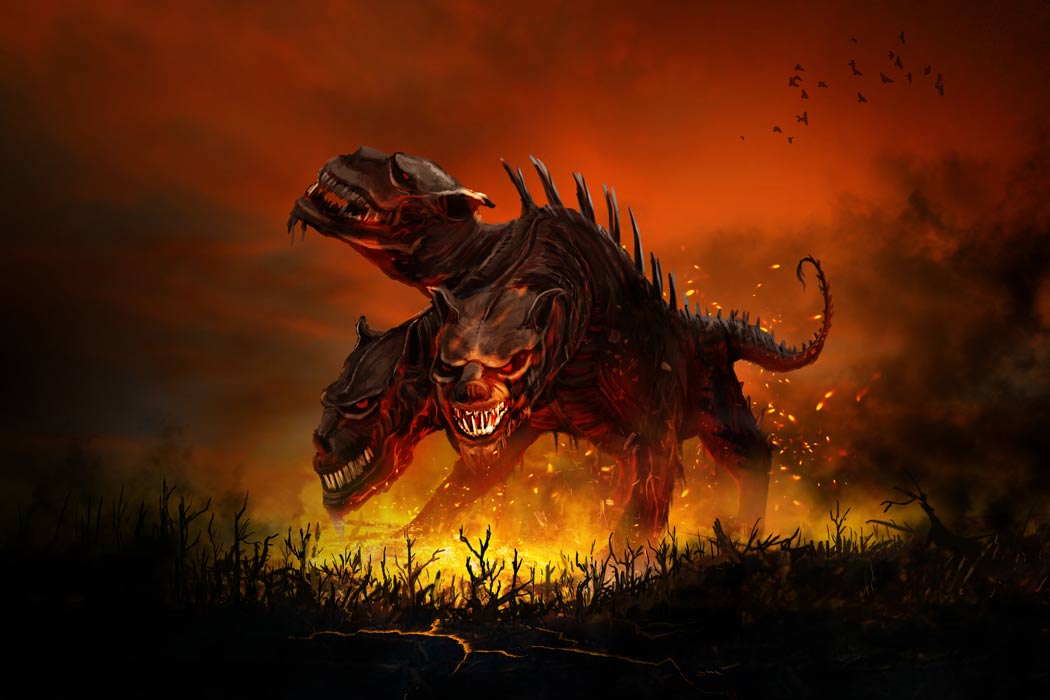How to Reskin D&D Monsters
As a Game Master for Dungeons & Dragons, building memorable encounters for your players often requires striking a delicate balance between the story you have in mind and the game mechanics that power the system. A particular monster or NPC might fit the theme or plot you’re going for, but it might not be a good match for your players’ characters in terms of level or abilities. A reskin of D&D monsters might be just what you need.
One solution is to reskin an existing monster. Reskinning D&D Monsters refers to changing the description of some bit of rules in the game while leaving the associated game mechanics (mostly) the same. A GM could easily reskin any number of things, from spells to magic items to feats or other abilities. In this article, we’re going to be focusing on reskinning D&D monsters.
Don’t Reinvent the Wheel (or the Kobold)
D&D 5E is a carefully balanced and heavily playtested game. While the challenge rating system isn’t perfect, it does offer the GM a method to ensure a given combat is reasonably balanced for the level of the PCs. Assuming you’re using the system properly, there’s very little chance of accidentally wiping your party out because you chose the wrong monster or boring them with encounters that are way too weak to challenge them.
Unfortunately, all that careful balance and playtesting can create a less flexible environment for the GM. A monster’s stats, its hit points, attack bonus, armor class, and other mechanical traits work together to provide its overall challenge rating. It can take a lot of work, and a lot of playtesting, to get that stat balance just right. That makes it difficult to create monsters on the fly or to adjust the stats of an existing creature to meet the appropriate level of your player characters.
Fortunately, there’s really no need to do any heavy mechanical lifting or search through stacks of books to find the perfect monster. With a little imagination, you can take a creature that’s close to what you’re looking for and, with minimal tweaking to its stats and description, reskin it until it’s a perfect fit for your adventure.
A Simple Example: CR 2 Brute
Let’s say you need a CR 2 monster to represent a particularly tough human. The extraordinarily tough champion of an underground pit fighting circuit, for example. You’ve already described this brute to your players in the form of rumors and whispers. He’s nearly 7 feet tall with wild hair and a long beard. He wears huge furry boots and swings a chain around the fighting pit like a maniac. You’re obviously unlikely to find this exact character in any published book, and you certainly didn’t expect to need his stat block. 
So…just reskin an Ogre.
The Ogre’s challenge rating is 2, which is just what you’re looking for. An Ogre is a big, strong brute who wears very little armor, just like your pit fighter. Change up the monster’s description, pretend its great club is a heavy chain, and viola…instant pit fighter!
Dungeons & Dragons has a lot of published monsters available. Even if you stick to just the official books, between the Monster Manual, Mordenkainen’s Tome of Foes, and Volo’s Guide to Monsters, there are many hundreds of usable monsters right at your fingertips. If you’re willing to do a little reskinning, you can turn those hundreds into thousands. All it takes is a little imagination and a minimal amount of effort. Let’s look a little deeper at two potential approaches to reskinning.
Reskinning Technique 1: The Palette Swap
The palette swap is the simplest reskinning method. The name refers to a technique from old RPG video games. To save game memory, programmers would reuse existing monster graphics by changing their color palettes.
Pictured: Two TOTALLY different monsters.
A palette swap is the kind of reskinning we did with the Ogre example, above. Similar to those old video games, we’re reusing something that already exists (the stat block) and swapping it out for a brand new image (the description of the monster). Let’s look at another palette swap reskin.
Palette Swap Example: The Otyugh
Otyughs are big, three-legged monsters that eat trash and other, even less appetizing refuse. In 5E, they possess a weak form of telepathy, a bite that causes disease, two tentacle attacks, and a special slam they can use when grappling.
![]() Let’s reskin the Otyugh as different sort of disease-causing monster: a giant rat. Since we’re not making any changes to the monster’s stat block at all, we’ll have to fit all of the Otyugh’s existing stats and abilities into our idea of a giant rat. The weirdest ability is probably the Otyugh’s limited telepathy. I guess a giant psychic rat could be some sort of wizard experiment gone wrong. Let’s go with that, and name the new monster the Abominable Vermin. Here’s a description:
Let’s reskin the Otyugh as different sort of disease-causing monster: a giant rat. Since we’re not making any changes to the monster’s stat block at all, we’ll have to fit all of the Otyugh’s existing stats and abilities into our idea of a giant rat. The weirdest ability is probably the Otyugh’s limited telepathy. I guess a giant psychic rat could be some sort of wizard experiment gone wrong. Let’s go with that, and name the new monster the Abominable Vermin. Here’s a description:
“An Abominable Vermin resembles a huge rat, roughly the size of a draft horse. The creature is obviously mutated and magically altered, and its body is covered in bulbous, skin-colored growths and purple splotches. Two large tentacles, pink and segmented, sprout from the rat’s shoulders. Its black eyes, three in total, shine with surprising intelligence.”
Otyugh’s have their own language, which doesn’t make much sense for the Abominable Vermin. I’d probably change it to Common and rule that the monster can’t actually speak, only understand spoken language. Beyond that, the limited telepathy, diseased bite, and tentacle attacks work just fine for the new monster.
Palette Swapping the Otyugh into the Abominable Vermin took about 5 minutes of thought and basically zero mechanical changes.
Reskinning Technique 2: Flavor Change
This second technique requires a little bit more work than a simple palette swap. Instead of only changing the description and name of the monster, a flavor change involves making small mechanical alterations to the monster’s stat block in order to fit a particular theme or feel. In other words, the monster’s flavor.
 Examples of changes might include transforming a fire-based creature into one associated with cold or another element. You might turn a Hell Hound into a Frost Cat by changing its description and swapping its fire-based abilities for cold. Most of the time, a flavor change shouldn’t involve majorly altering any base mechanics, although you should definitely change up a creatures powers, vulnerabilities, and resistances to make sure it jibes with your new concept.
Examples of changes might include transforming a fire-based creature into one associated with cold or another element. You might turn a Hell Hound into a Frost Cat by changing its description and swapping its fire-based abilities for cold. Most of the time, a flavor change shouldn’t involve majorly altering any base mechanics, although you should definitely change up a creatures powers, vulnerabilities, and resistances to make sure it jibes with your new concept.
The first step is to come up with the monster’s theme, its name, and its general appearance. Next, identify any aspects of the monster’s stats that don’t mesh with the new theme and change them. Doing so, you may find you have to make small changes to the monster’s stats. Try to keep these to a minimum, but don’t be afraid to tweak things as you feel is appropriate. After you’ve noted any stat changes, give the monster a new description and you’re good to go.
Flavor Change Example: Mummy
For this example, we’re going to use a flavor swap reskin to turn an undead monster into a construct. Here’s a little background flavor to set things up:
The PCs have uncovered the location of a powerful magical item, the Black Dagger of Korik, locked within the fabled Basalt Ziggurat. We want to place a pair of CR 3 creatures to guard the magic dagger. Because we imagine the guardians as creatures capable of standing watch underground for long periods of time without rest, we’re looking for a monster that doesn’t eat or sleep.
A mummy might meet our needs. It’s the right CR and it certainly doesn’t require rest. But, let’s say we don’t want to use an undead monster. Instead, let’s change the mummy’s flavor and turn it into a construct.
![]() The first step is deciding on the new monster’s name and basic concept. We already described the monster as a kind of guardian that doesn’t require rest. Let’s roll with that and call it a “Ceaseless Sentinel”. I’m imagining a kind of clockwork humanoid creature, full of gears and machinery. Its body is made of bronze, with limbs connected via mechanical joints. The creature wears a bright green cloak that’s a symbol of its role as a guardian. Maybe there’s a symbol on the cloak that’s common to all Ceaseless Sentinels: an eye set in a golden shield.
The first step is deciding on the new monster’s name and basic concept. We already described the monster as a kind of guardian that doesn’t require rest. Let’s roll with that and call it a “Ceaseless Sentinel”. I’m imagining a kind of clockwork humanoid creature, full of gears and machinery. Its body is made of bronze, with limbs connected via mechanical joints. The creature wears a bright green cloak that’s a symbol of its role as a guardian. Maybe there’s a symbol on the cloak that’s common to all Ceaseless Sentinels: an eye set in a golden shield.
Next, we need to look at the rest of the mummy stat block and identify what needs changing. Since we’re making more changes here than we did with a simple Palette Swap, I’m going to analyze the key aspects of the mummy’s stat block one by one.
Medium undead, lawful evil: Change undead to construct. Instead of Lawful Evil, let’s go with Lawful Neutral. These monsters guard things, and they follow orders while doing so.
Damage Vulnerability to Fire: Fire vulnerability doesn’t make much sense for our bronze construct. We don’t want to toss out the vulnerability completely, as that could potentially change the CR of our monster. Instead, let’s change fire vulnerability to cold vulnerability. Cold gums up the creature’s inner workings and wreaks havoc on its magical circuitry.
Rotting Fist: This ability is a great fit for the mummy, but it doesn’t work well for the Ceaseless Sentinel. I’m going to rewrite the ability. Since this is a reskin, I will leave as much of the attack the same as I can. I’ll only make changes where I need to in order to fit the theme of our new creature.
Sleepless Strike. Melee Weapon Attack: +5 to hit, reach 5 ft., one target. Hit: 10 (2d6 + 3) bludgeoning damage plus 10 (3d6) lightning damage. Target creature must succeed on a DC 12 Constitution saving throw or be inflicted with a curse of sleeplessness. The cursed target cannot sleep, can’t regain hit points, and its Intelligence decreases by 3 (1d6) for every 24 hours that elapse. If the curse reduces the target’s Intelligence to 0, its mind dies, leaving its body an empty, mindless shell. The curse lasts until removed by a remove curse spell or similar magic.
The biggest change I made here was altering mummy rot. I turned that curse from one that drains hit points into an effect that drains a victim’s Intelligence. While different, the effects of either curse don’t really matter in the course of a single encounter, so changing them doesn’t really alter the CR of the monster. I also changed the attack’s additional damage from necrotic to lightning, as I didn’t feel that necrotic damage makes much sense for the new monster. I left everything else about the attack the same, including damage and DCs.
Dreadful Glare: I don’t think we really need to change any of the mechanics of this ability. Instead of dreadful glare, let’s call it Stunning Beam. In combat, I’d describe the Stunning Beam as a ray of green energy the Ceaseless Sentinel fires from its eyes, a magical effect it uses to stop intruders.
The final step is to give the new monster a quick description. Here’s one:
 Ceaseless Sentinel: This humanoid creature is made of bronze that gleans with a dull, polished shine. It wears a long green cloak, emblazoned with the emblem of a golden eye set in a square shield. Although it bears no visible weapons, the creature holds itself with a soldier’s bearing, rigid and alert. From within its metal chest, you can hear the ticking of mechanical devices and the whirring of hidden gears.
Ceaseless Sentinel: This humanoid creature is made of bronze that gleans with a dull, polished shine. It wears a long green cloak, emblazoned with the emblem of a golden eye set in a square shield. Although it bears no visible weapons, the creature holds itself with a soldier’s bearing, rigid and alert. From within its metal chest, you can hear the ticking of mechanical devices and the whirring of hidden gears.
Final Thoughts
Be sure to make note of any reskinned monsters that particularly capture your player’s imaginations. Between sessions, you can further flesh out the lore and background of those monsters until they become as fully detailed as any published D&D monster. Make up a couple of variants (which can also be reskinned monsters) and give the new monster an ecology and some history. Done correctly, you can use reskinned monsters to help give your home campaign a lot of unique flavor while still relying on the core mechanics of the 5E game engine.
